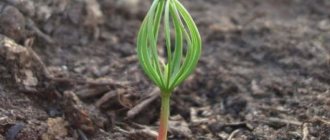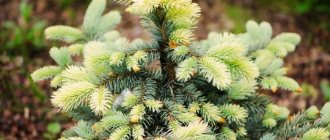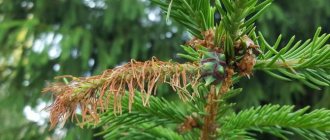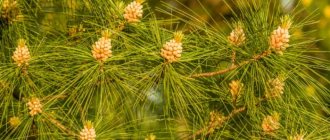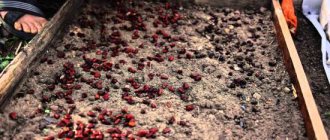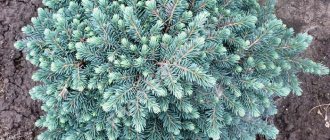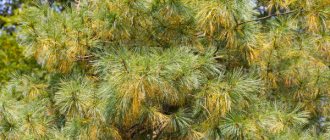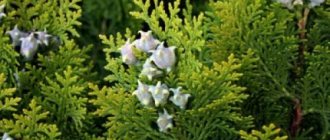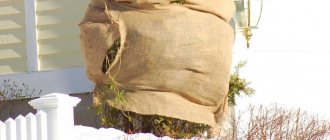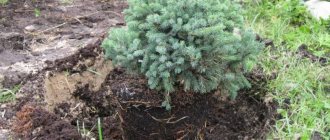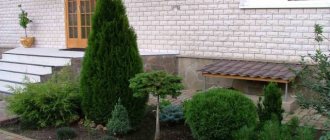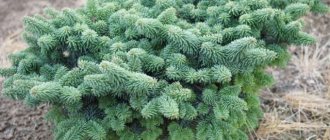Hermes: what is it?
Hermes is a whole group of pests; they belong to the group of Homoptera. Small insects living on needles, no more than 2 mm in length. The aphid becomes black or brown in color, the body is elongated, and there are antennae on the head.
To protect the spruce from the spread of pests, it is better to plant it away from other coniferous crops (fir, larch). The optimal distance is 600 m.
The pest feeds on juices obtained from pine needles and shoots. It prefers spruce most of all, as well as pine. You can notice the presence of this parasite at the very end of spring by the modification of the needles: they become yellow, bend, and become covered with a whitish coating. This light fluff also envelops the buds and young shoots. The plaque is a shelter and protection for Hermes larvae. If the plant is infected, then in the summer the branches become overgrown with galls - cones.
What to do if hermes appear on conifers
Last updated Feb 1, 2019
2 399 0
Hermes (scientific name Adelgidae) are microscopic aphids. It settles on coniferous trees, which is why growths (galls) form on them. Because of these pests, the needles turn yellow, become deformed, and stop growing.
Hermes: what is it?
Hermes is a whole group of pests; they belong to the group of Homoptera. Small insects living on needles, no more than 2 mm in length. The aphid becomes black or brown in color, the body is elongated, and there are antennae on the head.
To protect the spruce from the spread of pests, it is better to plant it away from other coniferous crops (fir, larch). The optimal distance is 600 m.
The pest feeds on juices obtained from pine needles and shoots. It prefers spruce most of all, as well as pine. You can notice the presence of this parasite at the very end of spring by the modification of the needles: they become yellow, bend, and become covered with a whitish coating. This light fluff also envelops the buds and young shoots. The plaque is a shelter and protection for Hermes larvae. If the plant is infected, then in the summer the branches become overgrown with galls - cones.
Hermes: symptoms of damage and main types of pest
This sucking parasite is quite difficult in its development. It requires two different trees: larch and spruce. Often these conifers grow close to each other, which ensures full development of Hermes. Insect larvae live on larch; their bodies are covered with wax and down. They drink all the juices from the needles, causing them to turn yellow, dry out, and fall off. Galls form on fir trees. At first they are beige in color, which turns first to green and then to brown.
Shoots affected by galls cannot be restored.
Types of Hermes:
- Yellow Hermes. One generation of parasites develops in one season. The female feeds on the sap of the needles, and then forms an oblong gall, it reaches a length of up to 20 cm. The formation is green with a red outline. In the middle of it, the female hides eggs, from which larvae emerge.
- Late spruce Hermes. The female of this pest forms light greenish galls. She prefers buds located at the end of the branches. The insect feeds on juice and produces saliva, which is involved in the formation of the seal. Spruce Hermes lays eggs in autumn. In the spring, larvae emerge from them, which leave the gall in the summer and spread throughout the coniferous tree. The development of the parasite and its reproduction occurs on one tree; lateral shoots are most often affected.
- Subbark spruce hermes. A distinctive feature of this spruce parasite is the absence of galls. The insects are wingless, they live only on spruce trees, located on the bark of branches or the trunk of a tree. This is where the white coating forms.
Another well-known species of spruce parasite is green hermes. The female develops a ball-like gall 2 or 3 cm in size and lays eggs there. In the summer months, winged insects fly out of it and flock to the larch to reproduce.
https://www..com/watch?v=BtXBYzNxVxE
Methods to combat Hermes
It is important to understand that Hermes is not an infection, but an insect, a parasite. Therefore, control methods should be selected accordingly. The first step is to inspect the tree, remove all shoots on which galls are found, and burn them. The procedure is carried out in early or mid-spring, until the larvae have grown. The next step is to wash the wood.
It is necessary in order to remove insects using water pressure. Only after this is treatment carried out with drugs. You can spray the spruce with a solution of mineral oil at the rate of 150 ml for every 5 liters of water. If this does not help, then the spruce trees are treated with insecticides. Confidor Maxi, Balazo are suitable, you can use Caesar, Mospilan.
Aktara, Prestige, and Commander give a good effect.
When the larvae emerge from the gall, it remains on the branches for quite a long time and gradually dries out.
The insecticide solution is prepared strictly according to the instructions indicated on the product packaging. The volume is calculated based on the number of coniferous plantations, and the frequency of spraying is selected depending on the degree of pest damage. Insecticides have a stronger effect on adult individuals that migrate, as well as on “vagrants”.
To ensure that these parasites are eliminated, treatment is carried out several times during the season:
- Early in spring and late in autumn to destroy wintering hermes.
- In the third ten days of April or the first week of May, when tree shoots and, accordingly, larvae are actively developing.
- First ten days of July. At this time, the galls mature and wingless insects appear.
- With the onset of August. This treatment is aimed at getting rid of the nymphs that emerge from the galls.
It is best to use different insecticides, alternating their use. Treatment is not stopped until the whitish “fluff” on the coniferous trees disappears.
Preventive measures and increasing the resistance of trees to insects
To prevent damage to coniferous plants in a summer cottage, certain measures must be taken.
Ways to increase tree stability:
- Do not plant Christmas trees in open areas and places that have drafts. It is also not recommended to grow trees in areas where there is a risk of flooding.
- To grow a tree in loose soil, the soil must be fertile and always slightly acidic. If necessary, acidify the soil with peat or fallen pine needles.
- Within a year after planting the spruce tree, it is watered not only at the root, but also the entire crown is sprayed.
- To improve rooting, when planting, seedlings must be treated with Kornevin or Radifarm.
- Three times a season, with intervals of up to 20 days, coniferous crops are treated with agents to enhance immunity. Epin, sodium humate, and Megafol are suitable.
- The soil around the trunk is covered with crushed pine bark.
- The crown is sprayed with fertilizers for coniferous trees (Iovofert, Reacom-needles).
Hermes: symptoms of damage and main types of pest
This sucking parasite is quite difficult in its development. It requires two different trees: larch and spruce. Often these conifers grow close to each other, which ensures full development of Hermes. Insect larvae live on larch; their bodies are covered with wax and down. They drink all the juices from the needles, causing them to turn yellow, dry out, and fall off. Galls form on fir trees. At first they are beige in color, which turns first to green and then to brown.
Shoots affected by galls cannot be restored.
Another well-known species of spruce parasite is green hermes. The female develops a ball-like gall 2 or 3 cm in size and lays eggs there. In the summer months, winged insects fly out of it and flock to the larch to reproduce.
Spruce hermes
Signs of damage by hermes spruce are the presence of galls on the shoots of the plant. A gall is an unnatural growth of spruce shoot tissue that is shaped like a cone. The galls serve as a kind of “home” for the ripening of insect eggs and their release for subsequent feeding. When laying eggs, adult insects secrete a peculiar chemical substance that provokes abnormal growth of shoot tissue and lays eggs. By the time the eggs mature, the gall has already formed and begins to fulfill its function of protecting insect larvae. In the photo on the left are spruce needles infected with Hermes. The needles begin to crumble and lose color, but adult insects are not visible at a quick glance.
Methods to combat Hermes
When the larvae emerge from the gall, it remains on the branches for quite a long time and gradually dries out.
The insecticide solution is prepared strictly according to the instructions indicated on the product packaging. The volume is calculated based on the number of coniferous plantations, and the frequency of spraying is selected depending on the degree of pest damage. Insecticides have a stronger effect on adult individuals that migrate, as well as on “vagrants”.
To ensure that these parasites are eliminated, treatment is carried out several times during the season:
- Early in spring and late in autumn to destroy wintering hermes.
- In the third ten days of April or the first week of May, when tree shoots and, accordingly, larvae are actively developing.
- First ten days of July. At this time, the galls mature and wingless insects appear.
- With the onset of August. This treatment is aimed at getting rid of the nymphs that emerge from the galls.
It is best to use different insecticides, alternating their use. Treatment is not stopped until the whitish “fluff” on the coniferous trees disappears.
Hermes on conifers
Hermes are tiny aphids belonging to the family (Adelgidae). They feed on coniferous trees, causing yellowing and bending of needles, death of needles, and stunting of growth. Aphids form unsightly growths called galls.
Hermes, depending on the species, infect only one plant . But they can change the “breadwinner” in the process of development. Common spruce (less commonly gray, Serbian, Sitka) and larch are most often attacked , but they can also be seen on pine, fir, and pseudo-hemlock. The most frequent visitor to the sites is the Spruce-fir hermes (Aphrastasia pectinatae). An adult insect is usually from 1 to 4 mm. The larvae are smaller, however, rarely noticeable, as they feed in shelter - surrounded by a white, fluffy coating or in the middle of galls (knob-like formations). In the development cycle we can meet both winged and wingless insects.
Symptoms - how to recognize hermes on spruce and larch
Hermes spruce-larch (Adelges laricis) has a complex development cycle. For full development, it needs two carriers - spruce and larch (hence the name spruce-larch). These trees usually grow in close proximity. On larch - small larvae, covered with waxy down, appear, pierce the tissue and suck out the juice, at the feeding site the needle breaks, a yellow spot forms, over time the needles turn brown and dry out. On spruce - on young, non-woody, fresh shoots, growths appear - galls . At first cream, later green, violet-green, pinkish, and finally brown. The shoot most often dies as a result of deformation.
Preventive measures and increasing the resistance of trees to insects
To prevent damage to coniferous plants in a summer cottage, certain measures must be taken.
Ways to increase tree stability:
- Do not plant Christmas trees in open areas and places that have drafts. It is also not recommended to grow trees in areas where there is a risk of flooding.
- To grow a tree in loose soil, the soil must be fertile and always slightly acidic. If necessary, acidify the soil with peat or fallen pine needles.
- Within a year after planting the spruce tree, it is watered not only at the root, but also the entire crown is sprayed.
- To improve rooting, when planting, seedlings must be treated with Kornevin or Radifarm.
- Three times a season, with intervals of up to 20 days, coniferous crops are treated with agents to enhance immunity. Epin, sodium humate, and Megafol are suitable.
- The soil around the trunk is covered with crushed pine bark.
- The crown is sprayed with fertilizers for coniferous trees (Iovofert, Reacom-needles).
When purchasing seedlings, they should be inspected. If insects are found, they must be destroyed before planting the tree, and branches with galls must be cut off.
If you know what kind of pest Hermes is and how to combat it, then you can safely grow coniferous crops on your site.
Read also: Grape variety “Gala”
Hermes is a pest of coniferous trees. How to deal with it?
In gardens, parks, and personal plots, many people plant coniferous trees, which not only bring benefits by purifying the air, but are also an undoubted decoration. Tall proud cedars, fluffy spruces, fragrant larches and other representatives of conifers have long earned the title of favorites of landscape designers. Of course, you want to preserve such beauty for a long time!
But for a tree to please with its appearance, it must be healthy, which means that it requires not only watering, but also timely treatment for all kinds of insect pests, for example, Hermes. Hermes is a conifer pest most likely to be found on your favorite blue spruce. Let's get to know this parasite better, and at the same time learn how to deal with Hermes.
Who are Hermes?
Hermes is very common on conifers. Take a closer look at the spruce: in late spring you can see white fluff on the young branches of an infected tree, and by August galls will appear. In general, Hermes are related to insects such as phylloxtera and aphids; they are just as small and also live in colonies. There are a lot of species of this aphid, and they harm trees in “waves,” that is, some become active in the spring, and others by the end of summer. However, the development cycle of this insect does not vary much from species to species.
Hermes feed on the sap of conifers, as a result of which new growths are formed on the branches - galls, their continuation is young shoots, which, deprived of normal nutrition, soon die off. Around May, females lay eggs in the galls, and after a couple of months the hatched larvae are ready to feed on succulent needles. The result is yellowed and out-of-shape needles, slow growth, and a decrease in the overall tone of the plant.
Harm of Hermes
In general, it cannot be said that a Hermes colony is capable of destroying a tree on its own. However, the damage is obvious: it is not only the appearance of the plant that suffers. The general immunity of larch or spruce is weakened, that is, the tree no longer becomes able to resist many diseases. It is not surprising that if mold appears on the affected plant, other parasites besides aphids will appear. But Hermes is also a carrier of various dangerous bacteria!
Reasons for appearance
To minimize the risk of similar pests appearing on pine, spruce, and larch, the tree should not be watered too much, but fertilizing should be done regularly. However, most often a seedling enters a garden or plot when it is already sick. Therefore, you need to buy coniferous seedlings from trusted nurseries, and even in this case you need to carefully examine the branches, especially their underside. You should not bring a seedling from the forest, because... he is not adapted to landing and may be sick.
How to deal with Hermes
If Hermes, a pest of coniferous trees, is found on a tree, you must immediately begin a campaign to destroy the pest. Many people don’t know how to deal with Hermes, or they give up. Indeed, getting rid of this aphid is not easy. The fact is that the colony must be destroyed in a comprehensive manner, so that both the adults, the larvae, and the eggs in the galls die. To do this, trees are sprayed with insecticides - “Aktara” or “Commander”.
It is not difficult to prepare the solution, but whether it will work properly depends on the method of spraying. A hand sprayer is a weak assistant here, because the body of the aphid is covered with a special protective fluff that will simply trap droplets of poison. Therefore, to destroy Hermes, you need to use professional fine sprayers, which create a cloud of toxic fog and are guaranteed to allow the insecticide to reach its target.
Hermes on conifers is an unpleasant, but completely avoidable phenomenon. It is important to notice traces of aphid activity in time and stop the spread of the insect. Then your favorite coniferous trees will delight you all year round!
What Hermes looks like, measures to combat the pest of coniferous trees
A coniferous tree is always a decoration for a garden plot, as it looks elegant and impressive all year round.
Pine, spruce, fir and larch are considered more resistant to disease than deciduous trees, but even these plants are susceptible to pest attacks.
Read also: How to plant and grow raspberries of the “Firebird” variety
In this article we will talk about Hermes - one of the most common pests of coniferous trees, since many gardeners are not even aware of the existence of Hermes, and do not know what it is.
Hermes on fir and larch
The primary signs of damage to fir and larch by sherry are fading of the beauty of appearance. First of all, the crown of the fir thins out, the needles become red, sparse, dry and have an unkempt appearance. Trees begin to hurt from the lower branches.
Also, upon careful examination, you can notice an unhealthy brown coating on fir needles and in old shoots, which is where parasites first settle.
Unlike cedar, it is more difficult to notice the symptoms of the disease on fir, since it is not covered with fluff, and yellowing of the branches can also be caused by other infections. In this case, you need to select treatment very carefully, since a mistake can only aggravate the situation.
As for larch, we can say that it gets sick less often. The needles on this species are renewed annually, so pests settle on it less often. But it is also more difficult to detect them, since larch does not turn yellow, but remains green all summer. Despite this, if it grows next to other coniferous species, it must also be inspected for the presence of insects, and in case of illness, treated along with other crops.
Hermes - what kind of pest is this?
Hermes (Adelgidae) is a group of insect pests of coniferous plants from the order Homoptera, related to phylloxera and aphids.
Hermes can be given the following description:
a small sucking insect up to 2 mm long, black or dark brown in color, with an oblong body and antennae on the head, externally reminiscent of an aphid.
Hermes feeds on the juice of twigs, shoots and pine needles, sucking it out of young trees. Spruce and pine are the most susceptible to attacks by this parasite. The vital activity of Hermes will tell you how to detect the pest on a tree: the needles bend and turn yellow, and at the end of spring a white coating or fluff appears on it, as well as on the buds and last year’s shoots.
The white coating is nothing more than a fibrous cover that covers the Hermes larva. In a plant affected by this parasite, from June to August, hard galls appear on young shoots, resembling a pineapple in appearance, from the scales of which the tops of the needles protrude and sometimes resin protrudes.
Red herme aphid: how to combat the pest, prevention
Hermes (scientific name Adelgidae) are microscopic aphids. It settles on coniferous trees, which is why growths (galls) form on them. Because of these pests, the needles turn yellow, become deformed, and stop growing.
Hermes: description, types, symptoms of damage, control measures
At the end of spring, on coniferous trees, most often spruces and pines, you can notice some deviations from their normal growth and development: yellowing and curling of needles, white fluff covering the buds and shoots on the branches. This suggests that pests, Hermes, have appeared on coniferous crops, and the plants are in serious danger.
What are hermes
Hermes are very small, no more than 2 mm, insects, which are also called pine aphids. Outwardly they look like bugs. They have an elongated body of green, brown or black color, and on their head they have small antennae. These insects feed on the sap that is released from the needles and young shoots, and the white fluff on the branches serves as a reliable shelter that promotes the reproduction of larvae.
In the summer, coniferous trees infected with hermes become covered with galls - unhealthy growths similar to a fir cone, which actually serve to protect, grow and reproduce the larvae in them.
Symptoms of damage and main types of pests
Hermes is not one type of harmful sucking insects, but a whole group. The only thing they have in common is that they belong to the order Homoptera and feast on the juices of coniferous trees.
Pests can be migratory, that is, developing on two plants of different species, or they can be non-migratory, they choose one species and live on it.
Another sign by which pests can be divided is their development cycle. Some species develop in one year, while there are others that take as long as 2 years.
For example:
- Yellow Hermes. Develops in one season. Females feed on the sap of pine needles and, when laying eggs, form a huge gall, sometimes reaching 20 cm.
- Spruce-larch red hermes. Individuals are brown or black. It is a migratory species of coniferous parasite, living either on spruce or pine. Duration of development – 2 years.
- Spruce-larch green hermes. Individuals are mostly light shades of green. They develop within one season. The female green Hermes forms galls in which larvae develop. In the summer they turn into winged individuals and fly away to live and breed on the larch. Therefore, the species is also migratory.
- Hermes Weymouth pine. A non-migratory species that develops over one or two years.
- Subcortical spruce hermes. These pests live only on spruce and do not migrate. They have no wings, live mainly in the bark of branches and tree trunks and do not form galls
Source: https://elenaefimenko.ru/kustarniki-dekorativnye/krasnaya-tlya-herme-kak-borotsya-s-vreditelem-profilaktika
Features of the Hermes life cycle
The life cycle of Hermes is a rather complex process that consists of several stages; the cycle can be a year or two long. The duration of the life cycle depends on the type of Hermes.
Also, each species requires for its life activity either one type of tree or two, but in any case, spruce is always the original plant. The life cycle of Hermes has a peculiarity - asexual and sexual generations of insects alternate.
A sexually mature female Hermes releases her saliva into the bud of a spruce or pine tree; under the influence of this liquid, a gall is formed on the shoot, into which the female lays eggs in the fall. The galls contain fat and starch, in which the Hermes larva is born from the egg, which eats the nutritious contents of the gall. In each gall, up to 26 larvae can develop simultaneously, each in its own chamber.
As a rule, only Hermes eggs survive the winter; in the spring, larvae hatch from them, and then female founders without wings, which are capable of reproducing eggs without the participation of a male. This type of reproduction is also called parthenogenetic.
From the eggs laid by the founders during spring and summer, several winged generations emerge with parthenogenetic reproduction. These winged individuals are capable of settling over fairly large areas to feed and reproduce.
Closer to autumn, a wingless generation of females and males hatches; as a result of their mating, fertilized eggs are laid on the spruce for the winter. These overwintered eggs will hatch in the spring, and the cycle of life and reproduction will begin again.
Hermes species such as spruce-fir and spruce-larch breed several generations, each of which fulfills its mission and, if necessary, flies to another plant, thereby changing the food tree, and eventually returns to spruce again, thereby completing the life cycle . Other species live and reproduce within the same plant and are often wingless insects.
Plaque on cedar (Siberian pine)
Signs of cedars being affected by Hermes are the presence of white fluff on the needles, shoots and trunks of plants. If the pest is severely damaged, plaque can appear on the entire above-ground part of the plant: on the needles, on the shoots, and even on the trunks. In this case, the old fluff covers the shoots with a continuous veil and is difficult to remove from the plant, as if it were “glued.” The photo on the left shows a case of chronic Hermes infection that lasted for several years. And at the very beginning of pest invasion, only the shoots of the current year are affected. Fresh fluff is soft and can be easily removed from the needles with your fingers. When you rub the fluff between your fingers, sticky yellow-brown stains remain that are difficult to wash off with water. This sticky liquid is formed after crushing the pest larvae, which are poorly visible to the naked eye and securely hidden in a white fluffy shell.
The needles of the affected cedar slow down their growth, often become bent, and young affected shoots become lighter and shorten. The growth of the plant as a whole is inhibited. The decorative qualities of the tree suffer greatly. Gradually the plant dries out. Based on the quality of growth of shoots from previous years, one can conclude when the infection occurred, and based on the growth of the current year, one can make a forecast about the development of the disease. The more growth is suppressed year after year, the worse the prognosis. If the current year's shoot is noticeably different from previous ones - the needles are lighter, thinner, and the shoot itself is much shorter, then the prognosis is unfavorable. The weakest trees – those growing in the worst conditions – are the first to be affected. For example, a cedar growing in lowlands, on waterlogged soil, will lose its decorative value first, while a tree growing on well-drained soil can successfully resist pest attacks for several years.
Common types of Hermes
The most common are yellow Hermes, late spruce Hermes, subbark spruce Hermes and spruce-larch Hermes.
Subbark spruce hermes. This pest does not use galls for reproduction; individuals without wings are hatched and live on the bark of the trunk or branches of only one tree - spruce. You can detect the subbark hermes by the white coating on the bark - these are small female pests covered with a white fibrous substance. In this case, the pest affects European or Siberian spruce.
In the spring of next year, the overwintered larvae degenerate into false foundresses, each of which is capable of laying up to 200 eggs. From the laid eggs, a generation of females and males will appear, which will fly to the spruce to lay a new batch of eggs and remain there for the winter. These eggs hatch into females that lay only one egg, which will then give birth to a single foundress female capable of producing galls. This is how the cyclic reproduction and development of Hermes occurs with the participation of two varieties of trees.
Siberian Hermes
Amateur gardener A.P. contacted the editor by phone. Yarkov from Berezovsky with a question about the possible reason for the death of cedar seedlings in his garden plot. He associates the death of cedar seedlings with the appearance of a white fluffy coating on their shoots and needles and considers this a manifestation of signs of some kind of disease. He asks to tell us: what is a white fluffy coating, how to fight it, and could the appearance of this coating really cause the death of cedar seedlings? The appearance of a white fluffy coating on the shoots and needles of cedar plants - Siberian pine pine - is not a manifestation of any disease, but is a manifestation of the vital activity of an insect pest - Siberian Hermes. Siberian hermes belongs to the proboscis-sucking aphids, that is, it is an ordinary aphid. Siberian Hermes has larvae that overwinter. The eggs are dirty yellow. Larvae of I-II instars are dark yellow or brown. Nymphs are similar to adult females, but smaller. Females are dark brown or almost black. As a result of sucking Hermes, the needles and branches are covered with fluff and secretions of the pest. On cedar, Hermes lives on bark and needles. The beginning of oviposition is noted on the 20th of April. Oviposition lasts about a month. The number of yellowish-orange eggs laid in a clutch ranges from 1-4 to 50-60. Hatching of larvae begins in the first ten days of May. During the years of mass reproduction, there are 25 clutches of Hermes per shoot, concentrated either on the tips of the shoot or on individual needles. In the last days of May, individual young females of the first spring generation begin laying eggs. Females sit in groups of 5-10 under the scales and cracks in the bark of the shoots. A particularly large accumulation of them was noted at the tops of shoots. The fertility of females is from 3 to 80 eggs. In the first ten days of June, almost black females, larvae and eggs are observed on Siberian cedar. The emergence of larvae from eggs is very prolonged and very dependent on weather conditions. The larvae hatching from the eggs crawl along the shoot and become covered with a whitish coating. Females and ovipositors of the first spring generation are covered with long white threads. At the end of June and early July, females of the second, May generation of Hermes lay eggs. The third and fourth generations of settlers develop from eggs laid by females of the second and third generations at the end of June-July. The larvae – “false founders” – overwinter near the Siberian hermes. They are also covered with white down, but less dense and long than adult females. Their pubescence increases towards the end of October. Thus, the climatic conditions of the Middle Urals make it possible to develop one generation of Siberian Hermes on Siberian cedar within one month, and the number of parthenogenetic generations can reach four. Although in years with a cold growing season, the number of parthenogenetic generations may be limited to three. Siberian Hermes, together with Siberian cedar, also damages spruce. Therefore, when they grow together, it can switch from spruce to Siberian cedar and back. Siberian hermes is especially harmful to Siberian cedar at a young age when it colonizes all shoots and most of the needles. Such 1-10 year old cedar plants affected by Hermes are very depressed, significantly stunted in growth and often die. The literature notes that Siberian hermes is dangerous up to 20 years of age of Siberian pine. In cedar plants affected by Siberian hermes, shortening and lightening of the needles and faster yellowing and falling off are observed, shoot growth decreases and their curvature occurs, which, among other things, reduces their decorative qualities. The fight against Siberian hermes is carried out in the same ways as with other types of aphids, for example, green apple aphids. The most effective is early spring spraying of cedar plants with various insecticidal preparations, which are directed against overwintered larvae. Subsequent sprays are less effective, since spraying does not destroy the laid eggs, and many females are protected by the bark scales under which they sit. With a small number of pests, you can spray with infusions and decoctions of onion peels, garlic, delphinium, pine extract, celandine, dandelion, tobacco, shag, yarrow, ash and a number of other plants that have insecticidal effects. In case of strong and very strong pest infestation of cedar plants, they should be treated with Inta-Vir (1 tablet per 10 l of water), karbofos (75-90 g per 10 l of water), “Kinmiks” (2.5 ml per 10 l of water) , “Iskra” (1 tablet per 10 liters of water), as well as the preparations “Aktara”, “Arrivo”, “Aktellik”, “Decis”, “Karate”, “Fufan”, “Phosfamide”, “Fury”, “ Rogor", "Tzipi", "Citcor" and other approved and commercially available drugs, taking the method of use from the accompanying document of the drug. V.N. Shalamov
How to deal with hermes on trees
When fighting Hermes, you should not forget that this is not a disease, but a pest, and you can and should get rid of it, like a parasitic insect. If Hermes is found on a spruce or other coniferous plant, the first thing to do is to cut off and burn parts of the shoots with galls; it is advisable to do this in early summer, before the larvae living in them have fully developed.
Read also: Getting to know the most popular varieties of remontant raspberries
Then, in several passes, wash off the pests from the branches with a stream of water under pressure. After this, you need to spray the tree with a solution of mineral oil - 150 ml per 5 liters of water. If these gentle methods were not effective, the plant is treated with Aktara, Confidor, Mospilan or Komandor according to the instructions for use.
Preventive measures: how to increase resistance to pests
The most important preventive measure is not to plant larch near spruce, since the proximity of these plants has a beneficial effect on the reproduction of hermes.
Healthy spruce seedlings should be planted in loose and fertile soil, in dark, draft-free places.
It is recommended to mulch the soil with pine bark, and the plant can be treated with an immunity boosting agent - “Epin”, this will provide additional protection for coniferous trees from Hermes.
Periodic repeated spraying of coniferous trees with Decis or Fastak will serve as a preventive measure against Hermes.
Pine and spruce pests
The most common pests of spruce and pine are sawflies, aphids, mites and hermes. They can cause significant damage to coniferous plants.
Sawflies
The most common pest of pine and spruce trees is the red and common sawfly. These small caterpillars eat young spring shoots. At the same time, the branches look burnt and dry out. The hardest hit trees are pines, Canadian spruce, Norway spruce and Serbian spruce.
It is not difficult to fight the sawfly; the main thing is to notice the caterpillars in time and destroy them. To combat, you can use the chemicals Actellik, Fury, Decis, BI-58. And for prevention, it is enough to inspect the plants from May to the end of June.
Aphids are no less common on coniferous plants. She sucks the juice of young, juicy needles from mid-May to the end of June. To destroy female aphids and their larvae, use Confidor Maxi, Caesar or Actofit.
